Excited to learn more about UX design in 2024? Then check out these influential UX design books covering everything from UX design principles to the psychology behind decision-making.
UX design books are a great resource for those looking for guidance or advice on the processes and principles needed to create delightful user-centric experiences. Whether you’re a seasoned UX design professional looking to stay up to date on the latest discoveries and research in the field, or you’re a UX design newcomer hoping to learn the fundamentals and how to apply them in your work, there are books out there for every level of expertise.
In this article, we’ll be reviewing twelve of our favourite UX design books for you to consider adding to your reading list.
Contents:
- The Design of Everyday Things
- Hooked: How to Build Habit-Forming Products
- Don’t Make Me Think
- Rocket Surgery Made Easy
- No Bullshit Guide to UX
- Smashing UX Design: Foundations for Designing Online User Experiences
- Build Better Products: A Modern Approach to Building Successful User-Centered Products
- Universal Principles of Design
- Lean UX
- The User Experience Team of One
- UX for Beginners: A Crash Course in 100 Short Lessons
- Quantifying the User Experience
1. The Design of Everyday Things

Source: Amazon
Written by usability expert Donald A Norman, “The Design of Everyday Things”, takes the reader on a journey through the principles of excellent design and the impact well-designed and poorly-designed objects have on user behavior and experience. Published in 1988, this seminal work has become an essential read for designers and engineers in every industry seeking to create a seamless bridge between technology and human experience.
Key areas which are covered in the book include the main frameworks behind a human-centered design system, the three most critical areas of design, and the reasons why designers need to take into account principles additional to logic, for example, cognitive science, art, and psychology in order to design products that not only work better but also enable a more enjoyable experience for users.
Why you should read this book
A book that has significantly shaped the field of UX and product design, “The Design of Everyday Things” is a must-read for every UX designer due to the huge impact it has had on how we as users see and experience digital products today. Designers can use it to learn the foundational, timeless principles of design, better understand the importance of user psychology and behavior in product design, and onboard the tools needed to garner practical insights and actionable strategies that improve the usability and effectiveness of their designs.
2. Hooked: How to Build Habit-Forming Products
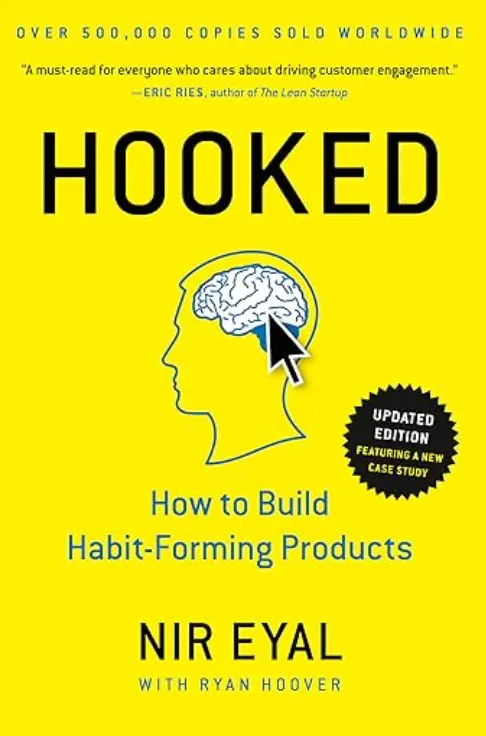
Source: Amazon
Author Nir Eyal explores the psychology behind habit formation within the context of product design in his book “Hooked: How to Build Habit-Forming Products”. Eyal takes the reader through the Hook Model, a framework consisting of four steps that demonstrate how user engagement is both created and sustained over time by successful products. Focusing on users’ base motivations and triggers and how these impulses impact decision-making and behavior, the author uses neuroscience, real-world examples, and psychological theory to provide readers with tangible insights that can inform the creation of habit-building products. Readers of the book come away with actionable and strategic advice on how to create products that compel users and cultivate habits; invaluable knowledge for those in the field of developing compelling digital experiences.
Why you should read this book
“Hooked: How to Build Habit-Forming Products” by Nir Eyal offers UX designers valuable insights into the psychology of user behavior and engagement. Understanding the four habit-forming components of the Hook Model, triggers, actions, variable rewards, and investments, is crucial for UX designers seeking to craft experiences that both attract users and encourage their long-term engagement with a brand, product, or service.

3. Don’t Make Me Think
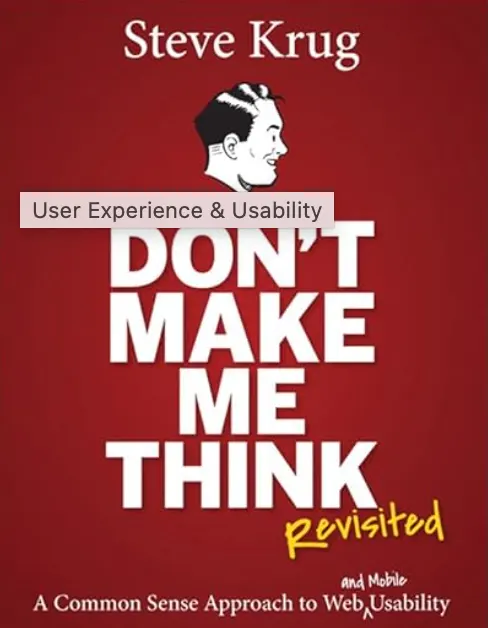
Source: Amazon
Steve Krug’s widely-acclaimed book on web and product usability, “Don’t Make Me Think”, digs into user-centered principles, focusing on the idea that well-designed websites should be highly intuitive for users and require minimal cognitive effort. The writing style of the guide is humorous and accessible, while the content emphasizes the often undervalued skill of creating products that are clear, simple, and easy to navigate. Designers are encouraged to create interfaces that promote effortlessness on behalf of the user, and Krug uses numerous practical examples, insights, and anecdotes to support and explain his ideas.
Why you should read this book
“Don’t Make Me Think” is considered a timeless usability resource and guide that provides foundational principles of UX design as relevant today as when it was published more than twenty years ago. Its accessible style means that the book can be used by anyone seeking to improve the usability and effectiveness of their products; from designers and developers to product owners and CEOs.
4. Rocket Surgery Made Easy
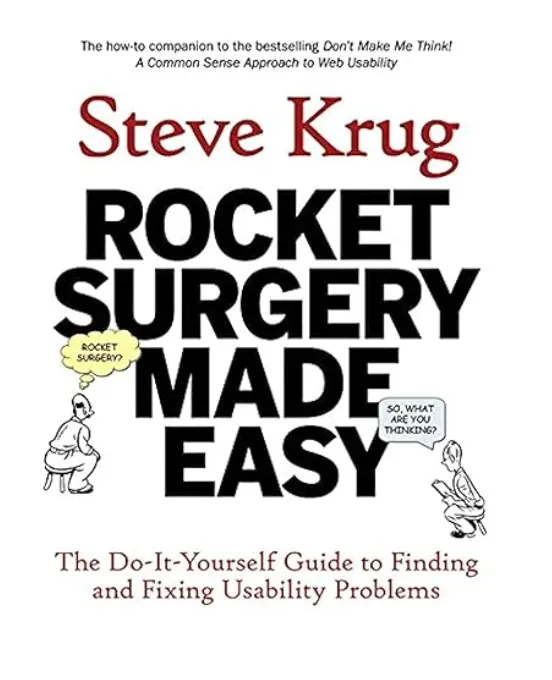
Source: Amazon
Building on the principles first introduced in his earlier book, “Don’t Make Me Think”, “Rocket Surgery Made Easy” offers readers a hands-on guide that simplifies the process of usability testing for UX designers and their teams. In this book, author Steve Krug offers a streamlined approach to usability testing that both junior and senior designers can apply to the design of their products. Encouraging the prioritization of real user feedback over elaborate methodologies and geared towards those looking to integrate usability testing seamlessly into their design processes, Krug uses a conversational writing style to deliver his advice, making this book accessible and welcoming to designers of all levels.
Why you should read this book
The main benefit of reading “Rocket Surgery Made Easy” is that readers have access to a practical guide to usability testing which minimizes complexity and enables its quick and effective implementation. In addition, Krug offers numerous cost-effective usability solutions that startups or freelancers on smaller budgets can benefit from.
5. No Bullshit Guide to UX
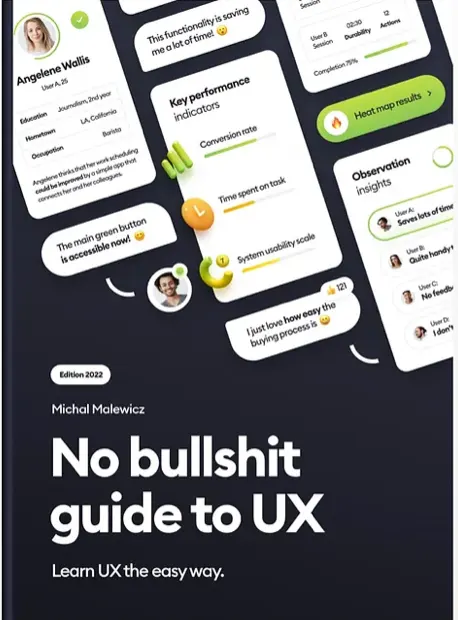
Source: Michal Malewicz
For those looking for a straightforward, hands-on guide to UX design that cuts through the jargon often associated with the field, the “No Bullshit Guide to UX” is an invaluable resource that demystifies the field and opens it up to anyone looking to design more user-centred and delightful digital experiences and interfaces. This ebook runs through key concepts, methodologies, and principles, providing a comprehensive account of UX design theory and practice that focuses on simplicity. Peppered with actionable insights and real-world use cases that enable readers to easily apply their knowledge, it is delivered in a no-nonsense, conversational style suitable for beginners and seasoned professionals alike.
Why you should read this book
The main benefit of reading this book is that it distills complex UX design principles and practices into straightforward and actionable insights that readers can immediately apply to their own work and design processes. While the book is perfect for those who are completely new to the field, the tone of the book makes it a fun and engaging read for UX designers of every level who wish to avoid jargon and learn from real-world examples.
6. Smashing UX Design: Foundations for Designing Online User Experiences
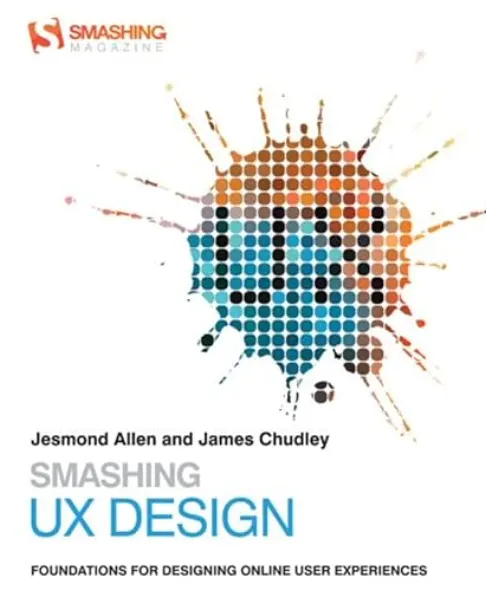
Source: Amazon
Written by Jesmond Allen and James Chudley, “Smashing UX Design: Foundations for Designing Online User Experiences” digs into the core principles of UX design with a particular focus on how to create compelling digital experiences for users. Running through each step of the UX design process in detail, from research and wireframing to prototyping and usability testing, the authors cover methodologies, techniques, and strategies that support and enhance each stage for the best results. The book offers readers a balanced combination of theory and practice, with case studies and practical examples sprinkled throughout to provide relevant context. The real-world examples, and the insights drawn from them, are used to provide readers with solutions they might wish to try out to solve their common design challenges.
Why you should read this book
There are numerous benefits to reading “Smashing UX Design: Foundations for Designing Online User Experiences”. First of all, this book is a comprehensive guide to user experience design, examining the main principles and methodologies used by UX designers. Secondly, as well as running through the theory, the book offers a range of practical techniques and examples that make more complex ideas easier to understand and apply in practice. Thirdly, the clear and entertaining writing style makes it accessible to all types of readers, from UX beginners to experienced professionals as well as those who are simply curious about the field.
7. Build Better Products: A Modern Approach to Building Successful User-Centered Products

Source: Amazon
If you’re focused on building products that truly center around the user and their needs, then this is the book for you. In her engaging guide, “Build Better Products: A Modern Approach to Building Successful User-Centered Products” author Laura Klein lays out the steps design and product development teams need to take to create successful and user-centered products and outcomes. The book runs through core elements of the UX design process, such as user research, prototyping, testing, and iteration, all the while placing heavy emphasis on the need for product teams to put the users’ needs at the heart of each stage. Klein uses an approachable and conversational writing style that is packed with real-world examples and hands-on advice. Whether you’re a product manager, a UX designer, or indeed anyone involved in the creation of digital products, this book is a must-read for ensuring users come away satisfied and delighted by the experience they have had with your product, ready to recommend your brand to others and becoming a repeat customer.
Why you should read this book
One of the stand out features of this book is its very modern approach. The author offers readers a contemporary product development methodology that neatly aligns with current industry practices making it perfect for startups and freelancers in the digital sphere. It also provides actionable insights and practical strategies so that readers can directly apply their knowledge of user-centered design to their own products as they go along. Real-world examples ensure the relatability of this content, while also providing valuable context to illustrate key concepts.
8. Universal Principles of Design
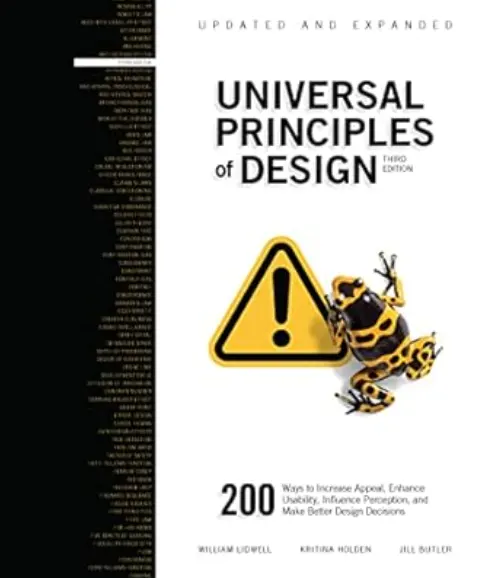
Source: Amazon
Authored by Jill Butler, Kritina Holden, and William Lidwell, “Universal Principles of Design” is an exploration into the fundamental principles that underlie effective design decisions. The book is divided into 125 different design concepts, from usability and accessibility guidelines to psychological principles, providing readers with a complete library of ideas and a comprehensive resource. Each design concept is explained and illustrated with a real-world example for context and relatability, and to provide an example of its application. The tone and style of the book are highly accessible as are the examples given, with the book intended to assist anyone in a creative career, from architects and artists to designers and product developers. With such a huge catalog of ideas and methodologies to hand–as well as that all-important theory–this book is ideal for both those seeking inspiration and newcomers to design who are looking to better understand the field’s core values and principles.
Why you should read this book
This book is a great resource for every kind of design professional. The structure of the book means it doesn’t need to be read from front to back but instead can be dipped in and out of as readers explore and gain a deeper understanding of 125 fundamental design principles that transcend specific sub-categories of design. With accessible content, timeless insights, and inspiration that covers psychological, perceptual, and usability aspects of design, this book will help designers of every kind return to the core principles of the field and find new ways to apply them.
9. Lean UX

Source: Amazon
Jeff Gothelf and Josh Seiden created the groundbreaking book “Lean UX: Designing Great Products with Agile Teams” in order to help UX design teams incorporate Lean and Agile methodologies into the UX design process. They do this through the promotion of a collaborative and iterative approach that places continuous learning and adaptability at the forefront of UX design work. Within these pages, UX designers learn the value of cross-functional teams, key concepts such as “validated learning”, and how to deliver impactful user experiences in a rapidly changing development environment.
Why you should read this book
“Lean UX” is the ideal read for those looking to learn how to integrate Lean and Agile methodologies into their work while gaining a deeper understanding of validated learning, rapid testing, and the value of creating minimum viable products to inform key design decisions that increase successful outcomes.
10. The User Experience Team of One
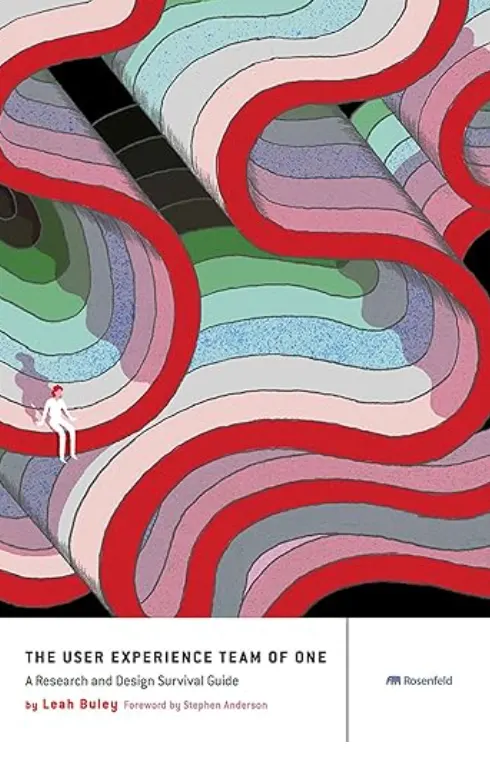
Source: Amazon
Leah Buley’s empowering guide “The User Experience Team of One”, seeks to solve challenges faced specifically by UX professionals working alone or in small teams within an organization. Offering techniques, strategies, and insights on elements varying from time management to limited resources, the book is a practical and invaluable resource for UX designers and encourages an entrepreneurial mindset. Buley emphasizes the need for UX professionals working alone to be proactive, collaborative, and strategic in their approach to solving problems, and supports her arguments with personal anecdotes, actionable tips, and relevant case studies.
Why you should read this book
Those who will benefit most from this book are UX designers who work freelance or alone within a company, unsupported by a large team. This book addresses the particular challenges those individuals frequently face and offers practical solutions. The book is also a great confidence builder for solo UX practitioners, with Buley’s actionable advice instilling a sense of agency in professionals when having to navigate the complexities that arise from working as a UX team of one.
11. UX for Beginners: A Crash Course in 100 Short Lessons
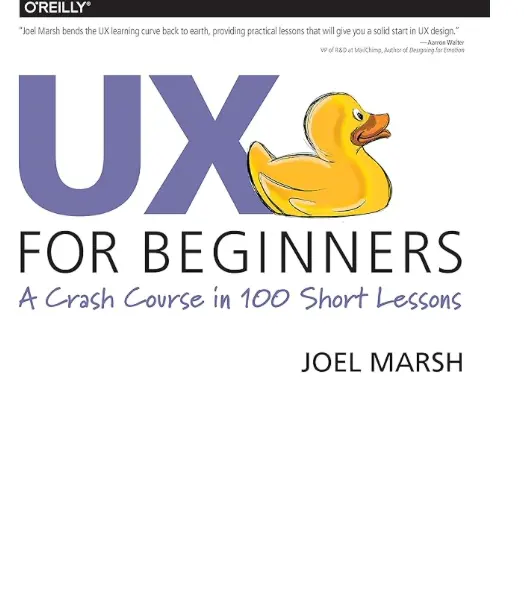
Source: Amazon
Created to demystify the world of UX design for newcomers, “UX for Beginners: A Crash Course in 100 Short Lessons” by Joel Marsh is the perfect introduction to the field. The author walks the reader through 100 short and easy-to-digest lessons, covering a wide range of UX methodologies, principles, and best practices using an accessible and conversational writing style. This comprehensive UX guide is aimed at all levels of expertise and is organised to provide the reader with bite-sized insights which make each lesson easy to absorb and apply. Marsh is a strong advocate of active learning, which he encourages through the inclusion of a number of hands-on exercises throughout the book.
Why you should read this book
With engaging lessons peppered throughout this engaging and accessible introduction to UX design, this book is ideal for those who want to apply their knowledge and learn from doing. The structured format of 100 short lessons makes the information easy to absorb while enabling readers to learn at a pace that suits them.
12. Quantifying the User Experience
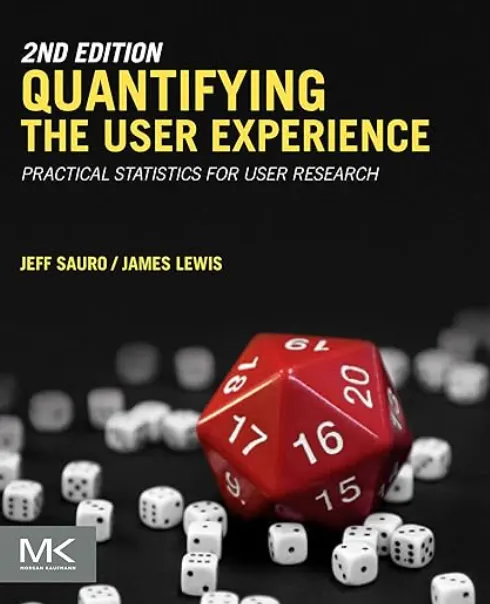
Source: Amazon
Jeff Sauro and James R. Lewis’s formative guide to the field of UX research and design, “Quantifying the User Experience”, cleverly unpacks the process of bringing quantitative data collection and analysis practices into the UX research toolkit, providing readers with a complete framework for performing meaningful and measurable evaluations. The book takes the reader through a wide range of quantitative methods, including surveys, benchmarking, and usability testing, supporting each with tangible examples and case studies.
Why you should read this book
This book sets itself apart by demonstrating to readers how to bridge the gap between statistical concepts and practical implementation. It does this by centring on the importance of precise, data-driven decision-making in the field of UX, inspiring readers to measure the impact of their designs and to promote user-centred thinking across organizations.
13. Conclusion
As this list demonstrates, books are a great way to get to know UX design principles and processes as well as gain hands-on advice from experts on applying that theory in real-world contexts. We hope that this list provides you with some inspiration for your UX design reading list for the coming year, whether your goal is to deepen your knowledge of UX design theory or incorporate new concepts into your established work processes.
If you’d like to learn more about UX design, now is a great time to consider taking a UX design course. Check out our round-up of the best UX design courses here.
We also highly recommend checking out our student-work for a practical understanding of how UX concepts are implemented in real projects. The UI UX Case Study by AND learner Shrikant Subramaniam could be a great starting point.
14. Next Steps
We hope our exhaustive compilation of UX design books will serve as a valuable resource. In case you have further queries, here are some additional resources you can refer to:
- Watch this session by Shiva Viswanathan, Design Head of Ogilvy Pennywise, and Naman Singh, Product Experience Designer at RED.
- Talk to a course advisor to discuss how you can transform your career with one of our courses.
- Pursue our UX UI Design courses – all courses are taught through live, interactive classes by industry experts, and some even offer a Job Guarantee.
- Take advantage of the scholarship and funding options that come with our courses to overcome any financial hurdle on the path of your career transformation.
Note: All information and/or data from external sources is believed to be accurate as of the date of publication.









